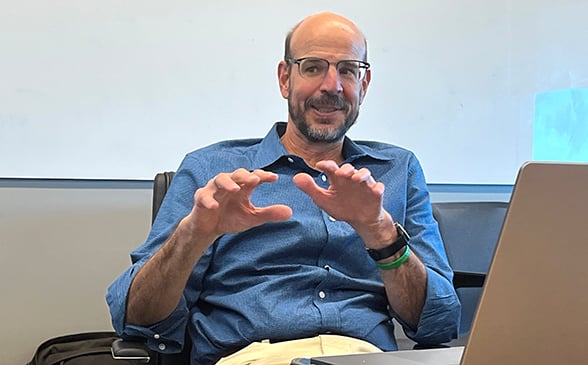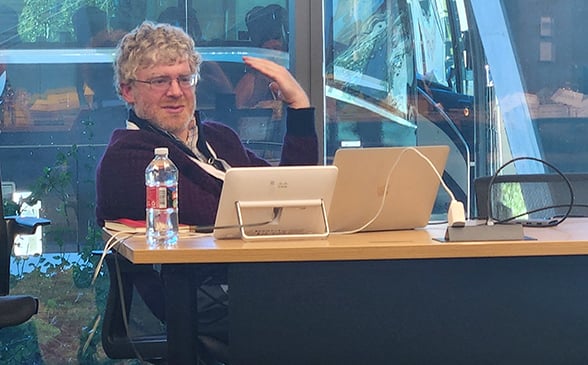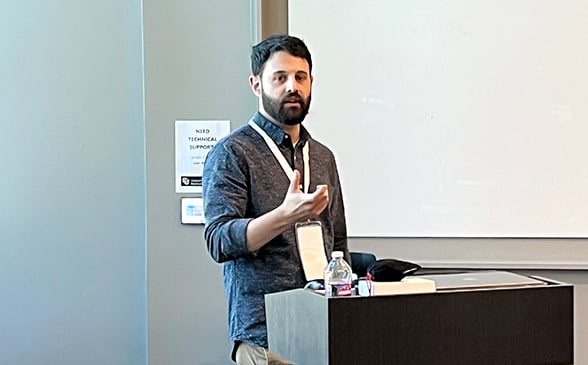The menu featured innovation and knowledge on Sunday as about 200 Science Writers 2023 participants attended a variety of talks during Lunch With a Scientist sessions. In small breakout groups, CU Anschutz researchers shared their expertise on a host of subjects, from psychedelics in medicine to AI in healthcare.
Get a taste for the breadth of research taking place on the CU Anschutz Medical Campus in these stories from the lively lunch discussions:
CAR T-cell therapy holds promise in blood, other cancers
Bone marrow transplants and chemotherapy can cure cancers of the blood such as acute lymphocytic leukemia (ALL) in about 40% of pediatric patients, but they are not without serious toxic side effects, including fatigue, bone damage and having the potential to develop into another cancer.
|
|
That is why scientists have long sought less-toxic therapies for treating leukemia and other blood cancers such as lymphoma. One new treatment that holds important promise is chimeric antigen receptor (CAR) T-Cell therapy. It involves genetically modifying patients’ T cells to target and kill cancer.
“We’re seeing unbelievable response rates in pediatric ALL, with 80% to 90% of patients going into complete remission, but that rate then flattens out to about 50% of patients after a year,” said Terry Fry, MD, a professor of pediatrics, hematology and immunology at the University of Colorado School of Medicine. “We’re trying to identify factors that will predict which patients will relapse.”
Fry is executive director of the Gates Institute, launched jointly by the Gates Frontiers Fund and CU Anschutz Medical Campus in 2023 to focus on translating laboratory findings into regenerative, cellular and gene therapies for patients.
Most cancer treatments involve a combination of drugs and other therapies that take aim at a variety of targets in cancer cells, and Fry believes that process will ultimately improve the success of CAR T-Cell therapy. He also sees promise for CAR T-Cell therapy in treating solid tumors such as those of the brain.
Concussions and youth sports: a complicated picture
A recent series of high-profile concussions in professional sports has brought the issue to the forefront in youth sports.
The topic was discussed during a session led by Christine Baugh, PhD, MPH, assistant professor in the Center for Bioethics and Humanities at the CU School of Medicine and assistant professor in the Injury & Violence Prevention Center at the Colorado School of Public Health. Her recent survey research examines the “interestingly complex” relationship parents have around concussion risk with their children playing contact and collision sports.
Baugh detailed the important role social norms play in shaping attitudes around sports and concussion risk – especially with the unique case of football. One of the bigger surprises in her research were the responses from children of former professional football players who witnessed firsthand the impacts of the sport: particularly neurodegenerative diseases and cognitive decline. These individuals – now parents themselves – had diverse and unique perspectives on the risks and benefits of football, she said.
“They responded to us that ‘football had enriched our family, and it’s hard to say no unilaterally to football, even seeing my dad’s decline,’” said Baugh.
Baugh added that adjusting the level of risk alongside the health and social benefits of youth sports will remain central to future research and public conversations around concussions.
The rise of AI: Will it bring health or harm?
Casey Greene, PhD, founding director of the University of Colorado School of Medicine’s Center for Health Artificial Intelligence and chair of the Department of Biomedical Informatics, led a discussion on the emerging role of artificial intelligence (AI) and ChatGPT in research and healthcare.
Greene recognized AI as a “powerful tool.” He introduced attendees to a workflow that he and others developed, called Manubot, which uses AI to help scientists write, edit and collaborate on manuscripts.

Casey Greene, PhD, talks about the implications of AI and Chat GPT in healthcare during a Lunch With a Scientist session.
According to Greene, AI also allows researchers to sort through large amounts of data, such as genomics, proteomics and transcriptomics, and identify patterns. Healthcare providers can then use that information to better treat patients. “It puts data at the forefront of care,” he said.
Greene acknowledged that AI, like many tools, can bring either health or harm.
“The School of Medicine has thought a lot about how to implement data to guide care in a responsible, ethical way. It’s going to be incumbent upon you all, as journalists and writers, and us, as folks who work in the field and build these systems, to keep ethics and human-centered elements at the forefront.”
What gun access can teach us about suicide prevention
Emmy Betz, MD, MPH, a professor of emergency medicine at the University of Colorado School of Medicine and co-founder of the Colorado Firearm Safety Coalition, discussed the rise in firearm suicides and gun violence across the U.S. along with the importance of creating safer options for firearm storage to help prevent injury and death.
“Ninety percent of those who attempt suicide with a firearm die. Firearms are used in about 50 percent of suicides in the U.S. On the other end, 90 percent of people who attempt suicide and survive don’t later die by suicide,” Betz said. “We are collaborating with public health professionals, clinicians, policymakers, the military and local communities to develop safer methods for storing firearms.”
|
|
Talking to the group, Betz said her team is using a multi-pronged approach to tackle this issue through research, education, collaboration and economics. Some ideas for safer storage include free/low-cost safes, locks and firearm storage outside the home if an individual is going through a crisis.
Betz also discussed research that is being conducted to help veterans, aging adults and their families handle issues with post-traumatic stress disorder and dementia.
Doctors target OCD with deep brain stimulation
A trio of top doctors at the University of Colorado School of Medicine demonstrated the multidisciplinary collaboration in the OCD Program, one of the few centers in the country that offers deep brain stimulation (DBS) for obsessive-compulsive disorder (OCD). The doctors discussed their unique perspectives as neurosurgeon, clinician, patient and advocate.
Steven Ojemann, MD, professor of clinical practice, neurosurgery, spoke about his viewpoint as a neurosurgeon who performed this procedure on Moksha Patel, MD, assistant professor of hospital medicine, in 2021. During the brain surgery, electrodes are implanted in the deeper structures of the brain and connected to generators in the chest that deliver small currents of electricity to the brain.
Rachel Davis, MD, associate professor of psychiatry, then discussed her clinical experience working with patients with OCD, specifically her work with Patel, whom she recommended for the surgery and whom she has provided exposure therapy to both before and after his undergoing DBS.
Patel shared his experience living with OCD and how DBS has significantly improved his quality of life. DBS is not a cure for OCD, but he feels much more cognitive flexibility with his obsessions and unwanted, intrusive thoughts, he said.
When asked how the DBS has changed his life, Patel responded, “I can make decisions based on what I value rather than what I fear.”
Psychedelic mushrooms on CU psychiatry researchers’ plate
Facing desperate patients whose depression defied any medication they tried, mental health providers were already searching for answers when psychedelic mushrooms began popping up in their conversations.
In response to that need, and to growing evidence in prestigious journals that the hallucinogenic was showing impressive results, a psychedelic program at the University of Colorado Department of Psychiatry was launched with Andrew Novick, MD, PhD, as principal investigator.
|
|
“There are sick people out there who really want to feel better,” Novick said. No one drug or combination of drugs works at all for at least 30% of patients, he said. “And we need to stop banging our heads against the same mechanism of action.”
Novick shared possible benefits of psychedelic therapy, including its potential rapid and long-term effect in one or two sessions as opposed to today’s more common chronic medication regimens that can take weeks to have an effect.
As Colorado prepares to roll out newly legalized treatment programs, Novick and colleague Scott Thompson, PhD, are conducting promising research on a way to block the hallucinogenic effect of the drug in an effort to overcome access barriers by reducing the need for long therapy sessions.
Currently, lengthy and expensive therapy is required with the psychedelic treatment option, Novick said. The goal is to encourage more research and open scientific dialogue so that it does not become a therapy just for the ultrawealthy, he said.
What super-athletes can teach us about disease treatment
With each study of elite athletes being pushed to physical extremes, CU Anschutz researchers get deeper insights into metabolic flexibility and what it means to general health and the potential to head off future disease.
Travis Nemkov, PhD, assistant professor in the Department of Biochemistry and Molecular Genetics at the CU School of Medicine, gave a presentation about what super-athletes can teach us about disease treatment.
|
|
Nemkov explained how researchers shifted their study of professional cyclists’ metabolomics, previously confined to a training room, onto the road of a competitive race. While the cyclists competed, blood samples were non-invasively collected from a small device attached to their shoulder. The dried blood droplets were then analyzed in the lab.
The platform allows the research team to collect detailed molecular data on anyone, not just athletes. “We’re trying to come up with a better information panel than the typical lab test, which is a single snapshot in time. … To transform healthcare we need to enhance the information that gets into these reports,” Nemkov said.
He added that a lot of metabolic-signature research has been done on hospitalized patients and sedentary people, as well as high-performing athletes on the other end of the spectrum. “Now the goal of our research is to fill this gap – we’re trying to figure out what else, physiologically, is going on in this (middle) area.”
The good and bad of fructose: its role in obesity
While talking about obesity and evolution, Richard Johnson, MD, professor at the University of Colorado School of Medicine specializing in renal disease and hypertension, said many animals are triggered at certain times of the year to gorge themselves to better survive the lean months of winter.
Bears can eat 10,000 grapes in 24 hours. Orangutans shovel down 100 pieces of fruit in one sitting. Hummingbirds guzzle so much nectar their livers turn pearly white with fat and they develop diabetes every day.
But it’s not permanent. Bears, birds and primates will become svelte again.
Humans were once the same. They evolved to overeat in times of plenty and burn it off in times of scarcity. Somewhere along the line the “switch” that turned this ancient impulse off got stuck, Johnson said. Now it's permanently “on.” Humans live in a time of relative abundance yet eat as if food will run out. And the biochemical mechanisms behind feeling full or satiated are often short-circuited.
Johnson, author of the book “Nature Wants Us To Be Fat,” discussed how sugar and fructose play key roles in obesity. He said glucose can be changed to fructose in humans. One easy way to avoid obesity, he said, is to drink water.

 Terry Fry, MD, discusses his CAR T-cell therapy research.
Terry Fry, MD, discusses his CAR T-cell therapy research. Emmy Betz, MD, MPH, discusses the rise in firearm suicides in gun violence across the United States.
Emmy Betz, MD, MPH, discusses the rise in firearm suicides in gun violence across the United States.  Andrew Novick, MD, PhD, shares insights on psychedelic treatments during a Lunch With a Scientist session.
Andrew Novick, MD, PhD, shares insights on psychedelic treatments during a Lunch With a Scientist session. Travis Nemkov, PhD, discusses what super-athletes can teach us about disease treatment.
Travis Nemkov, PhD, discusses what super-athletes can teach us about disease treatment. 

